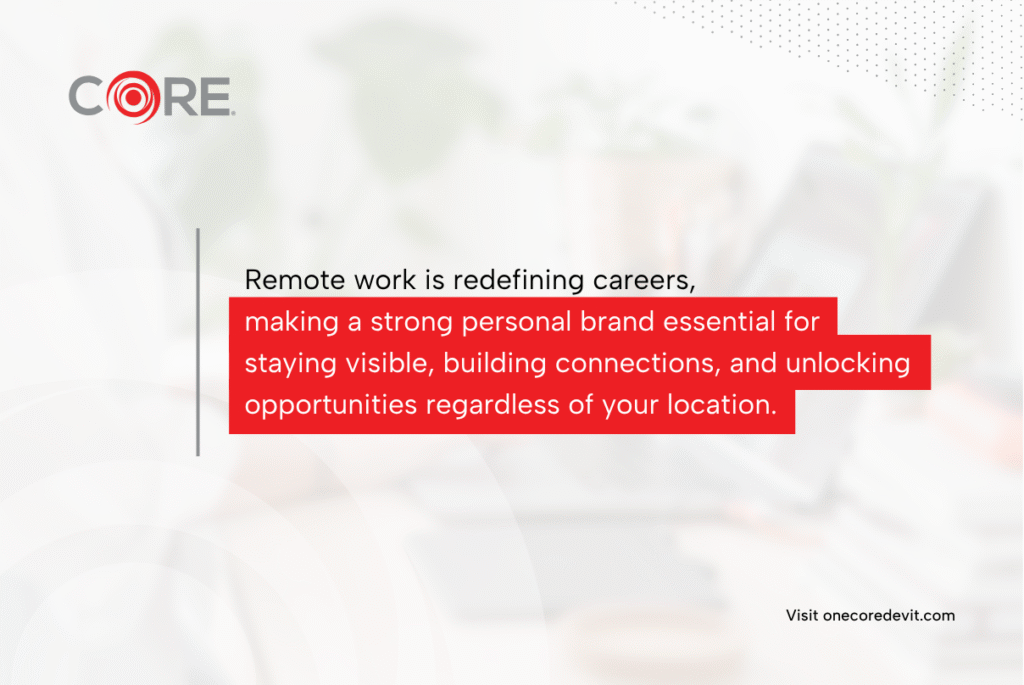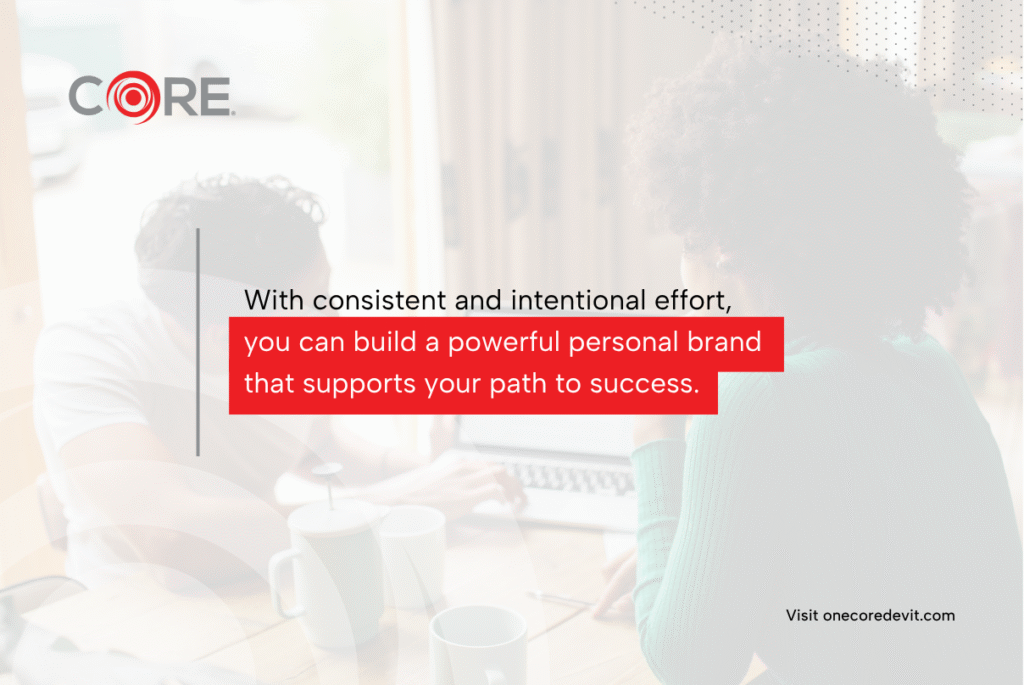Remote work is no longer just a temporary solution; it has become a lasting shift in how we approach our careers. Many professionals who can work from home are choosing to do so, while others are even considering career changes rather than returning to a traditional office full-time. As physical office spaces lose their central role in professional life, the need to maintain visibility in a virtual environment becomes more crucial than ever.
That’s where effective personal branding for remote work comes in. In a job market where your digital presence often makes the first impression, building a strong online brand helps you stand out, stay visible, and remain top of mind for new opportunities. By also learning how to craft and maintain your personal brand remotely, you can form meaningful connections and advance your career, no matter where you are in the world.
Related post: Personal Branding Remote Work: How to Stand Out as a Professional
Building Your Online Presence as a Remote Professional
In remote work environments, your online presence becomes your immediate first impression. It reflects your professionalism, work ethic, and personality, much like how you’d carry yourself in a physical office. That’s why cultivating a strong, authentic digital brand is key to standing out.
Optimizing Your Professional Profiles
Your remote brand should clearly communicate your values, skills, and expertise. Start by reviewing your online professional profiles, especially on platforms where networking and hiring are most active (e.g., LinkedIn, JobStreet, Indeed, and more). Keep these essential elements in mind:
- A professional headshot that reflects both competence and approachability
- A headline that does more than list your job title and highlights your unique value
- A summary that tells your career story and communicates what sets you apart
- Experience descriptions that focus on outcomes and achievements instead of tasks
- Skill endorsements and recommendations from colleagues or clients
Creating and Sharing Valuable Content
A strong personal brand is built on authenticity and expertise. By consistently creating and sharing valuable content, you demonstrate your knowledge and build credibility in your field. Here are some effective strategies:
- Write articles that offer insight into industry trends or challenges
- Comment thoughtfully on others’ posts to show engagement and awareness
- Share bite-sized content such as infographics, tips, or lessons learned
- Repurpose blog posts or videos across multiple platforms to expand your reach
- Stick to a consistent posting schedule to remain visible and relevant
Establishing Thought Leadership
Just as you would make a strong impression in person, your virtual professional image also requires intentional effort. Becoming a thought leader helps reinforce that image and opens up new opportunities. To grow your influence:
- Define and share your unique perspective or approach within your field
- Speak at virtual events, panels, or webinars to increase visibility
- Appear as a guest on podcasts to broaden your audience
- Contribute articles or guest posts to reputable industry publications
- Develop case studies that highlight successful projects and measurable results
Overall, by optimizing your digital profiles, sharing meaningful content, and embracing thought leadership, you also create lasting visibility and open doors to new remote opportunities.

Networking Strategies for Remote Workers
Without in-person events, remote workers need to be more deliberate about building professional relationships. Fortunately, there are many effective ways to network, even from behind a screen, such as:
Virtual Networking Techniques
As a remote professional, you can tap into various digital tools and platforms to expand your network. Consider these strategies:
- Attend virtual industry events: Engage actively by asking thoughtful questions and following up with speakers and other attendees afterward.
- Join online communities: Platforms such as Slack groups, Discord servers, and Facebook groups related to your field offer ongoing opportunities for connection and collaboration.
- Schedule virtual chats: Reconnect with former colleagues, classmates, or industry contacts through short, informal video conversations.
- Participate in X (formerly Twitter) chats or LinkedIn Live events: These real-time discussions help you meet professionals with similar interests.
- Host your own virtual events: Creating webinars or online discussion groups allows you to connect with others while showcasing your expertise.
Building Relationships Without In-Person Interaction
Developing meaningful professional relationships remotely requires a thoughtful and consistent approach. These strategies can further help you build and maintain strong connections:
- Be consistent with follow-ups: A personalized message after an initial meeting helps keep the relationship moving forward.
- Lead with value: Share helpful resources, job opportunities, or introductions without expecting anything in return.
- Use video whenever possible: Face-to-face interaction, even virtually, creates stronger connections than written communication alone.
- Remember personal details: Noting birthdays, work anniversaries, or shared interests makes your outreach feel more genuine.
- Create a networking schedule: Setting aside regular time each week for relationship-building ensures it becomes a sustainable habit.
Crafting a Professional Image in a Virtual Environment
Building a strong personal brand in a remote work setting takes more than just showing up online. It also requires intentionality, consistency, and the right tools. Without proper guidance, you may struggle to present a cohesive image across platforms. From visual elements to communication habits, every interaction contributes to how you are perceived in a virtual environment.
Visual Branding Elements
A consistent and polished visual presence strengthens your personal brand across platforms. Consider the following elements to ensure your image remains professional and recognizable:
- Consistent profile photos: Use the same high-quality headshot across all platforms.
- Cohesive color scheme and design: Apply consistent colors, fonts, and layout styles across your website, presentations, and social media.
- Professional virtual backgrounds: Choose or design virtual meeting backgrounds that align with your personal or professional brand.
- Branded email signature: Include your logo, job title, contact details, and relevant links in every email.
- Custom presentation templates: Use personalized slide decks to reinforce your brand identity during meetings or webinars.
Communication Style and Consistency
Your communication style is just as important as visual consistency. The way you write, speak, and respond shapes your professional reputation.
- Define your tone of voice: Decide whether your style is formal, approachable, technical, or inspiring, and keep it consistent.
- Create reusable templates: Prepare responses for common email scenarios to save time and maintain a unified tone.
- Establish boundaries for communication: Set clear expectations regarding your availability and typical response times.
- Engage through active listening: Show attentiveness in virtual meetings by asking questions, providing feedback, and summarizing key points.
- Polish your written communication: Since much of your remote interaction happens through writing, clarity and professionalism are essential.
Automation and Efficiency Tips
Maintaining your personal brand does not have to be time-consuming. With a few smart tools and systems, you can stay visible and consistent without overwhelming your schedule.
- Batch and schedule content: Set aside time each month to plan and schedule your social media posts.
- Use email templates: Streamline your outreach and follow-ups with ready-made message drafts.
- Monitor your online presence: Set up Google Alerts to stay informed about mentions of your name or industry terms.
- Repurpose content effectively: Turn blog posts into LinkedIn carousels, Instagram graphics, or short-form TikTok videos to reach wider audiences.
- Install an automated chatbot on your website: Ensure immediate responses to inquiries even when you are not online.
Lastly, by aligning your visuals, communication habits, and productivity tools, you create a professional image where every detail contributes to how you are remembered. So, it is important to be intentional with each one.

The Power of Personal Branding in Remote Work
In a distributed work environment, personal branding for remote work is no longer a luxury; it is a necessity for career growth. By thoughtfully curating your online presence, engaging in strategic networking, maintaining a consistent professional image, and using the right digital tools, you can build a strong personal brand that transcends physical boundaries and opens doors to new opportunities. With small, intentional steps taken consistently over time, your personal brand can ultimately work for you and help you achieve long-term success.
Related post: Managing Compliance: Philippines Labor Laws vs. U.S. Labor Standards
Frequently Asked Questions (FAQs)
Q1: How important is personal branding for remote workers?
Personal branding is essential for remote workers because it helps bridge the visibility gap created by the lack of face-to-face interactions. Without daily in-person engagement, a well-crafted personal brand keeps you top-of-mind for new opportunities, fosters trust with colleagues and clients, and clearly communicates your value in a competitive global market. Professionals who invest in their personal brand often attract significantly more career opportunities than those who don’t.
Q2: How often should I update my professional profiles?
You should update your professional profiles at least once every quarter. It’s also important to make timely updates whenever you complete major projects, earn new certifications, or transition into a new role. Keeping your profiles current shows that you’re actively managing your professional growth and ensures that your online presence accurately reflects your skills, achievements, and goals.
Q3: How can I measure the effectiveness of my personal branding remote work efforts?
To gauge how well your personal branding is working, track metrics like profile views, content engagement, network growth, and inbound opportunities such as job offers or speaking invitations. If you have a personal website, monitor its traffic as well. Some professionals also assess their “share of voice” by tracking industry mentions or citations. Set specific goals for these indicators each quarter to stay focused and measure your progress over time.
Q4: What are the 5 A’s of personal branding?
The 5 A’s of personal branding are Appearance, Alignment, Authenticity, Authority, and Audience. Together, they form the foundation of a strong personal brand by ensuring that how you present yourself aligns with your values, reflects your true identity, establishes credibility in your field, and connects with the right people.
Q5: What are the 3 C’s of personal branding?
The 3 C’s of personal branding are Clarity, Consistency, and Constancy. These principles guide you in defining your message clearly, delivering it uniformly across all platforms, and maintaining a steady presence to stay relevant and build lasting recognition.
Step into a workplace where growth is constant and talent is celebrated.
Apply to CORE® today.





